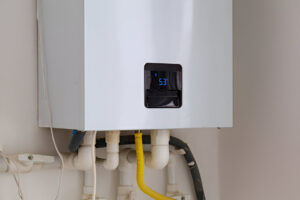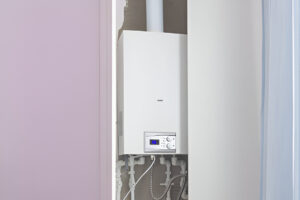How Does a Hot Water Geyser Work: 2025 Complete Guide
Many new homes have hot water geysers, which make it easy to get hot water for everyday tasks. If you know how does a hot water geyser work, you can take good care of it, save energy, and fix any issues that come up. This guide talks in great depth about the parts, how they work, and the different types of water heaters.
Basics of Hot Water Geysers
A hot water boiler, also known as a water heater, is a useful appliance that prepares water for use in your home while simultaneously heating it. A hot water spout is all about heating the water. It takes the energy already in the water, whether that’s from electricity or gas, and turns it into heat energy to make things warmer. Modern geysers are built with complex parts that make sure they heat water efficiently, keep a steady temperature, and include safety features.
So, the heating kicks off when cold water comes into the geyser tank through a pipe. So, depending on the type of pump, you’ll use either electric or gas fires to heat the water. It makes sense for the hot water to rise and the cooler water to sink. This is because of convection currents. The water is warm all the time.

Types of Hot Water Geysers and Their Operating Mechanisms
Electric Water Heaters
Electric geysers are the go-to choice for heating water in urban areas. Inside these units, electric heating elements warm the water in a sealed holding tank. Electrical resistance helps to heat water by allowing electricity to flow through materials that have high resistance, like nichrome. This creates heat that moves into the water. Visit our complete electric geyser buying guide for a full list of prices and brand differences in Pakistan.
Important Parts of Electric Geysers:
- There are upper and lower heating sources.
- Control device for thermostats
- Storage tank with insulation
- Valve for relieving pressure
- An anode sticks to stop rusting
- Dip tube for getting cold water
Gas Water Heaters
Gas-powered geysers derive their energy from natural gas or propane. At the base of the tank in these devices lies a gas stove that directly combusts fuel to heat the water. Most of the time, gas geysers heat water faster than electric ones. If the power goes out, they can still work.
Important Parts of Gas Geysers:
- A gas stove and a pilot light
- Safety gadget for thermocouples
- A pipe for letting waste gases out
- Relief valve for temperature and pressure
- Valve for gas control
- Chamber for burning
Tankless Water Heaters
The newest development in water heating technology is the tankless or quick water heater. These systems heat water on demand without needing a holding tank. They give you hot water for a long time and don’t take up much space. To learn how a water heater without a tank works. You need to know how the flow-activated heating device works.
Internal Components and Their Functions
Heating Elements
In electric geysers, the heating element is the most crucial part because it changes electrical energy into heat energy. Electric heaters are generally made of nichrome or another high-resistance material, and a timer controls them. Most normal electric water heaters have two heating elements: one that heats the water quickly and one that keeps the temperature steady. In our detailed electric geyser repair guide, you can find out more about element types and how much they cost to replace.
Thermostat System
The thermostat is like the brain of the water heater; it keeps an eye on and changes the temperature of the water. There is a thermostat in each element that sets the temperature by turning on and off the power to that element. Modern heaters have safety measures that keep things from getting too hot and lower the amount of energy they use.
Insulation and Tank Design
Multiple layers of insulation in the holding tank keep the water at the right temperature and reduce heat loss. This keeps the geyser from losing too much heat. The water temperature in a geyser usually drops by 1 degree Celsius every hour. If your business is well insulated, it will change how much energy it uses and how much it costs to run.
Safety Components
Geysers today have several safety features, such as:
- Temperature and pressure relief valves
- Anode rods for corrosion prevention
- Electrical safety switches
- Overflow protection systems

The Water Heating Process: Step-by-Step Operation
Initial Heating Phase
When you turn on a fountain for the first time, the timer checks to see how cold the water is and turns on the heating elements. The upper element is turned on first, which heats the top part of the tank and makes sure that hot water is ready quickly. This progressive heating method ensures that less energy is wasted and hot water is available faster.
Temperature Maintenance
The timer turns the heating elements on and off to keep the water at the right temperature once the temperature is met. This process has these parts:
- Temperature monitoring: Monitoring the temperature of the water all the time
- Element activation: Changing the hot parts based on the temperature needs
- Energy conservation: adjusting heating processes to use the least amount of electricity
- Safety monitoring: Making sure the temperature stays within the safe range
Water Distribution
Thermal stratification says that warm water will naturally rise to the top of the tank. This is how hot water is distributed. When you turn on a hot water faucet, hot water runs out of the top outlet and cold water comes in through the bottom outlet, keeping the supply steady.
Energy Efficiency and Modern Innovations
Smart Thermostats
Modern geysers have programmable timers that let users set heating plans. This way, less energy is used when the water isn’t being used. Intelligent temperature control in these systems can cut your power bills by up to 15%.
Improved Insulation Technologies
Modern insulation materials and methods have significantly improved energy efficiency. A gas blanket can cut electricity use by as much as 10%, so adding more insulation to older units is a good way to save money.
Heat Pump Technology
Modern heat pump water heaters use significantly less electricity than standard electric water heaters to heat water by extracting heat from the air. Compared to regular electric geysers, these methods can cut energy use by 60 to 70%. Check out our guide to electric geysers for up-to-date prices and estimates of how efficient they are.
Maintenance and Troubleshooting
Regular Maintenance Tasks
Proper care keeps the fountain running at its best and extends its life:
- Annual thermostat calibration: Making sure that temperature control is correct
- Element inspection: Looking for damage or signs of rust
- Anode rod replacement: Stopping tank rust
- Pressure valve testing: Making sure that safety measures work correctly
- Insulation assessment: figuring out which places need more protection
Common Issues and Solutions
Insufficient Hot Water: This is usually due to broken heating parts or a temperature setting error. The answer is to test the elements and change them if they need to be.
Strange Noises: Usually show dirt buildup or parts that are breaking. These problems can be fixed by cleaning the tank regularly and having a professional inspect it.
High Energy Bills: This can occur if there isn’t enough insulation, the units are too large, or the heating parts aren’t functioning correctly. An energy audit and changes to parts can make things work better.
Installation Considerations and Best Practices
Proper Sizing
How much water a family uses will help you choose the right geyser size. A 40- to 50-gallon tank is usually enough for a family of four, while 20- to 30-gallon tanks may be enough for smaller homes.
Location and Ventilation
For gas units in particular, proper placement requires sufficient airflow. Electric geysers need enough space around them so that repair workers can get to them and make the appropriate electrical connections.
Professional Installation
For upkeep, it’s essential to know how a hot water boiler works, but having a professional install it makes sure it’s safe and works at its best. Only licensed workers know how to connect gas lines, plumbing systems, and electrical connections correctly.
Environmental Impact and Sustainability
Energy Source Considerations
The impact of heating water on the world largely depends on the type of energy used. Electric geysers that get their power from green sources are more environmentally friendly than those that get their power from fossil fuels.
Water Conservation
Modern geysers have water-saving features like recirculation fans and fittings that use less water. This keeps the water level at a comfortable level.
Lifecycle Management
When you properly get rid of and recycle old geysers, you protect the earth and get back valuable materials like copper and steel.
Future Trends in Water Heating Technology
Smart Home Integration
Next-generation geysers are connected to Wi-Fi, which lets you watch and control them from afar using smartphone apps. In real time, these systems show how much energy is being used and send out maintenance warnings.
Solar Integration
Combining solar collectors with regular geysers in hybrid systems lowers the need for power from the grid while still providing a steady flow of hot water no matter the weather.
Advanced Materials
New coats and materials for tanks make them more resistant to rust and better at keeping heat in. This makes equipment last longer and requires less upkeep.
Cost Analysis and Economic Considerations
Initial Investment
Electric geysers usually cost less than gas ones at first, but the cost of placement depends on how much electricity is needed and how the geyser is connected to the power grid. Check out our complete electric heater price guide for a breakdown of prices and a comparison of brands in Pakistan.
Operating Costs
In places where natural gas is cheap, gas geysers tend to be more cost-effective, while electric units may be more cost-effective in areas where power rates are low.
Energy Efficiency Ratings
Energy Factor (EF) scores on modern geysers help people measure how efficient they are. Higher EF scores mean that the energy performance is better and the running costs are lower.
Technical Specifications and Performance Metrics
Recovery Rate
The recovery rate tells you how fast a spring can heat water again after it runs out. Most of the time, gas units can recover energy faster than electric units of the same size.
First Hour Rating
To determine the amount of hot water available during periods of high demand, this measure combines the holding capacity and recovery rate.
Standby Heat Loss
Sound insulation cuts down on idle heat loss, which is the energy used to keep water at the right temperature when no one is using it.
Conclusion
Homeowners can make wise choices about water heating systems when they know how a hot water spring works. Modern geysers offer dependable and effective hot water options for all of your home’s needs, from simple electric parts to complex smart settings. Regular upkeep, the right size, and using energy-efficient methods ensure the machine operates at its best, with minimal environmental impact and the lowest costs.
This guide lays out the basic rules for managing your water heater well, whether you’re thinking about installing a new system or making an old one work better. As technology keeps getting better, geysers of the future will be even more efficient, convenient, and environmentally friendly.
External References: